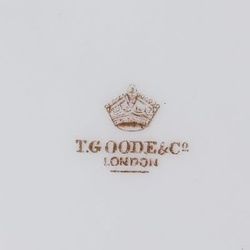
Когда Джозеф Споуд II ушел в отставку из Споуда в 1812 году, Уильям Коупленд стал управляющим. Коупленд присоединился к компании в 1784 году и управлял лондонским бизнесом после смерти Джосайи Споуда I. В 1822 году компания стала называться "Спод и Коупленд", а в 1824 году - "Спод, Коупленд и сын". Уильям Коупленд умер в 1825 году. Джозеф Спод II умер в 1828 году. В 1833 году сын Уильяма Коупленда, Уильям Тейлор Коупленд, и его партнер Гаррет взяли на себя управление бизнесом. Название компании было изменено на Copeland & Garret. Название Spode было сохранено в качестве фирменного наименования. В результате сохранения торговой марки Spode компанию часто называют Copeland-Spode. Гаррет оставался в товариществе до 1847 года.
Несмотря на то, что компания принадлежит семье Коупленд, имя Споуд часто встречается на многих производимых изделиях. Spode - это название фабрики, на которой производилось производство. Под управлением Copeland фабрика Spode продолжала производить многие популярные формы и узоры Spode. Фирма также посвятила свою энергию разработке нового фарфорового корпуса, известного как Parian, который использовался для изготовления бюстов, фигурок и статуй.
Спрос на богато украшенные, роскошные изделия в стиле рококо был очень высок. Под руководством Коупленда фабрика Spode производила одни из самых роскошных и впечатляющих изделий. Конкуренция с другими производителями, такими как Minton, приводила к появлению все более сложных конструкций. Коупленд-Споуд успешно выставлялся на выставках на протяжении всего 19-го века.
Регулярно добавлялись новые дизайны, и были выпущены тысячи различных линий. В викторианскую эпоху линейка продуктов расширилась, включив в себя предметы домашнего обихода, такие как напольная плитка, каминные решетки, дверные ручки и таблички. Сервировка обедов по-прежнему оставалась основой производства фабрики Спод. Трансферные изделия теперь можно было выпускать в гораздо более широкой цветовой гамме, чем прежние простые сине-белые узоры. Было произведено большое количество высококачественной трансферной посуды в широкой цветовой гамме. Подсчитано, что в период с 1833 по 1900 год было введено более 35 000 новых моделей.
Между 1847 и 1867 годами компания стала известна как W. T Copeland. В 1867 году название было изменено на W. Ти Коупленд и сыновья. В 1932 году она стала акционерным обществом с ограниченной ответственностью под названием W. T Copeland & Sons, Ltd. В 1970 году компания стала Spode, Ltd. В 2006 году компания Spode Ltd. объединилась с Royal Worcester. Новая компания вступила в конкурсное производство в ноябре 2008 года. В апреле 2009 года Portmeirion Group приобрела бренды Royal Worcester и Spode, продажа не включала производственные мощности Royal Worcester или Spode. Портмейрион продолжает выпускать голубые итальянские и лесные узоры Spodes.







